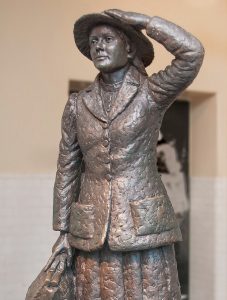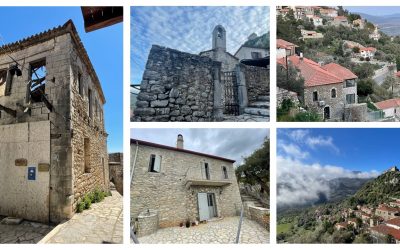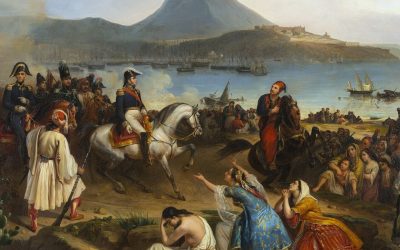Have you found your immigrant ancestor’s ship manifest? This is usually the first step in genealogy research for Greek-Americans. But apart from the valuable genealogical information included in the manifests, there is much more to learn about the history of our ancestors. While the causes of Greek emigration to the US, as well as the journey and conditions faced upon arrival, are common topics of discussion, the history of ocean liners that played a vital part in the migration of Greeks to the US is frequently disregarded, despite its importance in the immigrants’ experience. This article aims to shed more light on the history of Greek ocean liners, the ships that carried many of our ancestors to what was seen as the “Promised Land.”
Greek Emigration to the US: Causes and Conditions
In the late 19th century, Greece sought to boost its domestic economy by promoting agricultural crops, particularly raisins, for export. However, the raisin crisis of the 1890s, caused by stiff competition from France and the impact of climate change, led to a general economic downturn. In 1893, Greece went bankrupt, and a series of exhausting wars followed, including the Greco-Turkish War of 1897, the Macedonian Struggle (1904-1908), the Balkan Wars (1912-1913), the First World War (1914-1918), and the Asia Minor Campaign (1919-1922). These events had significant implications for Greek society and the economy, resulting in increased emigration. Many Greeks chose to emigrate in order to find immediate livelihood solutions or get away from the deadly military conflicts.
The journey from Greece to the United States during the late 19th and early 20th centuries was arduous, taking up to four weeks to complete. Initially, Greek emigrants had to make their way to European ports before boarding an ocean liner. Most would purchase a “steerage” ticket for $25, which granted them passage in the lower decks of the ship. These conditions were extremely poor, with minimal comforts, overcrowding, and subpar food. Sanitation was also an issue, with hygiene rules often ignored. The sheer number of people in steerage made it difficult to move around the ship, and fresh air was hard to come by. Those who could afford first or second class tickets enjoyed more comfortable conditions.
Arriving at Ellis Island: Inspection, examination, registration
When the ships arrived in the United States, they underwent a thorough health inspection. Inspectors boarded the ships as they passed through the narrow straits of Staten Island to examine the passengers for any communicable diseases. If the inspection went smoothly and no cases were detected, the ship lowered the yellow flag and continued its journey to the next stage. However, if a case was detected, all passengers were quarantined while the ship was fumigated and disinfected before the journey continued to its final destination.
Once the above process was completed, the ship approached Ellis Island where passengers disembarked, collected their luggage, and headed towards the island. Due to the excessive crowds, it was often needed to wait for days before being served. Passengers first arrived at the Main Building where they deposited their luggage before proceeding to the Line Inspection. Here, doctors conducted a “six-second physical” examination to detect any health problems. The doctors were supposed to be experienced enough to identify issues almost instantly. After the inspection, passengers moved to the registration hall where they were asked personal and financial questions. Sometimes, they used information from the passenger manifests, which were completed at the port of embarkation. If everything was fine, they received a disembarkation card and proceeded to their destinations.

The History of Greek Ocean Liner Companies
Until 1907, the Greek emigration flow was served by European shipping companies such as Messageries Maritimes and Fabre Line, which transported people to Marseille, and from there, by train to Le Havre and Hamburg to board ocean liners. Later, the “Austro Americana” and “Hamburg Americana” began departing directly from Patras. In 1907, Greek entrepreneur Dimitrios Moraitis attempted to establish a Greek ocean liner company but failed to secure the necessary funding. The company went bankrupt in 1908, and was succeeded by the Oceanic Greek Steam Navigation Company, which Moraitis established in collaboration with the manager of the Bank of Athens. However, this company also went bankrupt shortly afterward.
In 1912, the Empeirikos brothers took over the Greek emigration flow with the establishment of the National Steam Navigation Company of Greece. They acquired a fleet of ships, including the Patris, Macedonia, and King Constantine, which transported thousands of Greek immigrants to the United States. The company successfully withstood the challenges posed by World War I and the Greco-Turkish War, but in 1926, it was left without a fleet due to financial difficulties. Despite efforts to recover, the company was dissolved in 1937, marking the end of an era in Greek migration history.

Greek Ocean Liners and their History
The causes of Greek emigration to the US, as well as the journey and conditions faced upon arrival, are common topics of discussion. However, the history of the ships themselves is rarely discussed, despite being integrally intertwined with the history of the immigrants. The ocean liners varied in size, ownership, and fate, with some meeting tragic ends, while others were sold and renamed. Each ship had its own unique story, but together they represent a significant part of Greece’s maritime heritage.
Athenai
Athenai served the Piraeus-New York line. Its maiden voyage was on May 13, 1909, with a route from Piraeus to Kalamata, Patras, and New York In November 1912, it was requisitioned by the Greek government and used as a transport until June 23, 1913, when it resumed its journey between Piraeus and New York. Shortly thereafter, the ship was sold to the National Steamship Company, owned by the Empeirikos brothers. On October 22, 1914, it sailed from Piraeus to Kalamata, Patras, New York and remained on this route until September 16, 1915 when it sailed from New York. Three days later, the ship caught fire and was destroyed, but all 316 passengers and 120 crew members were rescued.

Constantinople
In 1921, this ship was sold to Byron Steam Navigation under the British flag and was renamed Constantinople. It was then assigned to the Constantinople-Piraeus-New York route in December 1921, completing eight round trips before its last voyage on September 4, 1923. The ship was later renamed King Alexander in 1924 and made four trips from Piraeus to Patras and New York between May 1924 and April 1925. It was finally scrapped in Venice, Italy in 1929.

Edison
In 1924, this vessel was sold to Byron Line (a British subsidiary of the Empeirikos Brothers) with a British flag and was named Edison. On October 16, 1924, it started the route Piraeus-Patras-Naples-New York. In August 1928, it passed to the ownership of the Hellenic National Steamship Company. On December 29, 1932, it started its final voyage on the route from New York to Boston and Piraeus. On July 30, 1935, it was sailed to Genoa to be dismantled.

Ioannina
In 1910, it was sold to D.M. Los of Piraeus and was named Eleni. In 1913, it was sold again, this time to the National Steam Navigation Company of Greece and was renamed Ioannina. It began its first journey under the new ownership on October 30, 1913, when it set sail from Piraeus to Kalamata, Patras, and New York. It continued its voyages until December 15, 1917, when a German submarine torpedoed it.

Vasilefs Konstantinos (Megali Hellas, Byron)
One of the most well-known Greek ocean liners, this vessel was built in 1915 for the National Steam Navigation Company of Greece, and was named after King Constantine I. It served the Piraeus-New York line. On May 13, 1915, it sailed from Piraeus for its maiden voyage with destinations in Patras, Naples, and New York.
In 1919, it was renamed Megali Hellas and on October 12, 1919, it resumed its journey to New York. On January 12, 1923, it started its last trip between Constantinople and New York, with intermediate stops in Piraeus, Patras, and Marseille.
Later that year, it was renamed Byron and served the Mediterranean ports-New York line. Its first trip for the new owners began on August 4, 1923, when it sailed from Constantinople to Piraeus, Patras, and New York. Its last trip on the Piraeus-Patras-New York line, under the British flag, began on July 25, 1928, when it sailed from Piraeus to New York. It then returned to the National Steam Navigation Company of Greece under the Greek flag. Its last trip for the company was on October 2, 1935, when it sailed from Piraeus to Lisbon, New York, Boston, and back to the Azores, Lisbon, and Piraeus. At some point, the Greek government cut subsidies to the company, resulting in its dissolution.

Madonna
On March 10, 1925, it started serving the route from from Constantinople to Piraeus, Livorno, New York, and back to Marseille. From 1927 and onwards, it served the West African line, and in May 1934 it was scrapped in Italy.

Madeconia
This vessel was built in 1912 for the National Steam Navigation Company of Greece with the Greek flag under the name Macedonia. It served the Patras-New York route. With the declaration of the Balkan Wars, the ship was requisitioned by the Greek government. On January 4, 1913, while undergoing repairs in Syros, it was bombed by the Turkish warship Hamidiye and sank.

Moraitis (Themistocles)
The ocean liner was built in 1907 for the Hellenic Oceanic Steam Navigation Company, flying the Greek flag, with the name “Moraitis”. It served the route Piraeus-New York. On September 5th, 1908, it made its last trip from Smyrna-Piraeus-Patra-Algiers to New York. Later that year, the company went bankrupt, and the ship was transferred to its creditors, who renamed it “Themistocles”.
On November 12th, 1908, it made its first trip from Smyrna-Piraeus-Kalamata-Patra to New York. However, the new company also went bankrupt, and in 1912 it was absorbed by the National Steam Navigation Company of Greece, owned by the Empeirikos brothers. On July 12th, 1913, it resumed the Piraeus-New York route, and on October 24th, 1914, it started its last trip from Piraeus-Kalamata-Patra to New York. On November 21st, 1914, it made its first trip on the Piraeus-Kalamata-Patra-Palermo-New York route, and on August 28th, 1924, it made its last trip from Piraeus-Kalamata-Patra to New York, except for an isolated trip from Piraeus to New York on September 14th, 1927. It was scrapped in 1933.

Patris
Patris is one of the most well-known Greek ocean liners. It was built in 1908 for the National Steam Navigation Company of Greece. It was launched on December 23, 1908 and started its maiden voyage on March 27, 1909, from Smyrna to Piraeus, Kalamata, Patra, and New York. In 1913, it was requisitioned and used as a hospital. On June 12, 1913, it resumed its voyages from Patra to Piraeus to New York, and on December 6, 1920, it set sail for its final voyage from Piraeus to New York. In April 1925, it was sold to the Messageries Maritimes of Marseille, under the French flag, and renamed Claude Chappe. It was scrapped on June 15, 1939, in Hong Kong.

Thessaloniki
In 1913, this ship was sold to the National Steam Navigation Company of Greece and was named Thessaloniki. It made its first voyage for its new owners on February 16, 1914, when it departed from Piraeus for Kalamata, Patras, Palermo, and New York. On November 24, 1915, it set sail from Piraeus to New York, but on December 22, the captain sent a distress signal when the ship became uncontrollable due to engine failure. The passengers and the majority of the crew boarded the Patris, which headed to New York. Eventually, the ship was abandoned on January 5, 1916.

About the Author
Sofia Pitsineli studied history at the University of Athens, Greece, and works as a research assistant at Greek Ancestry.



